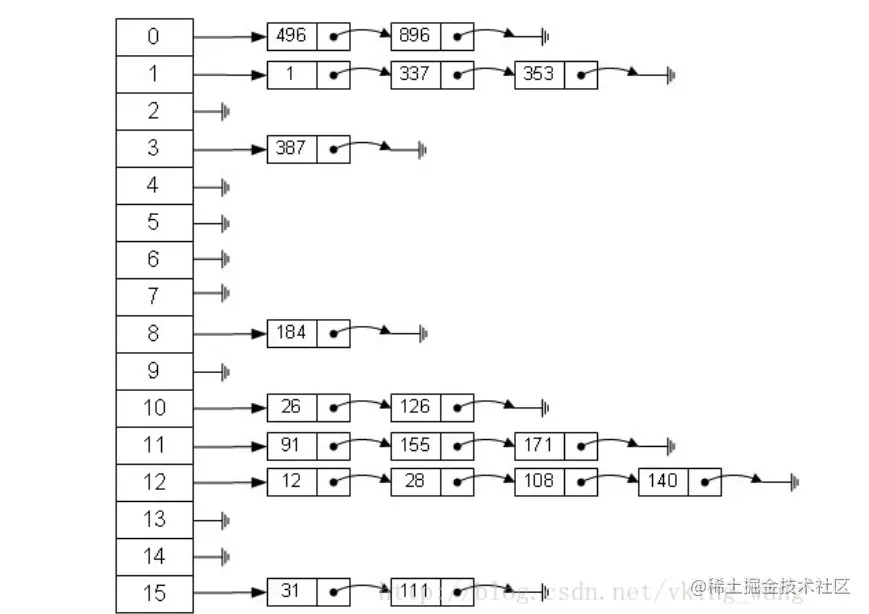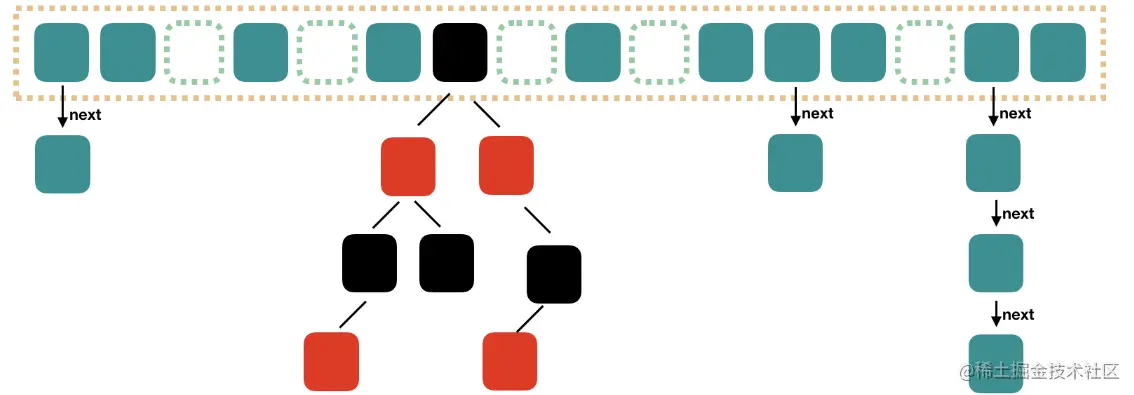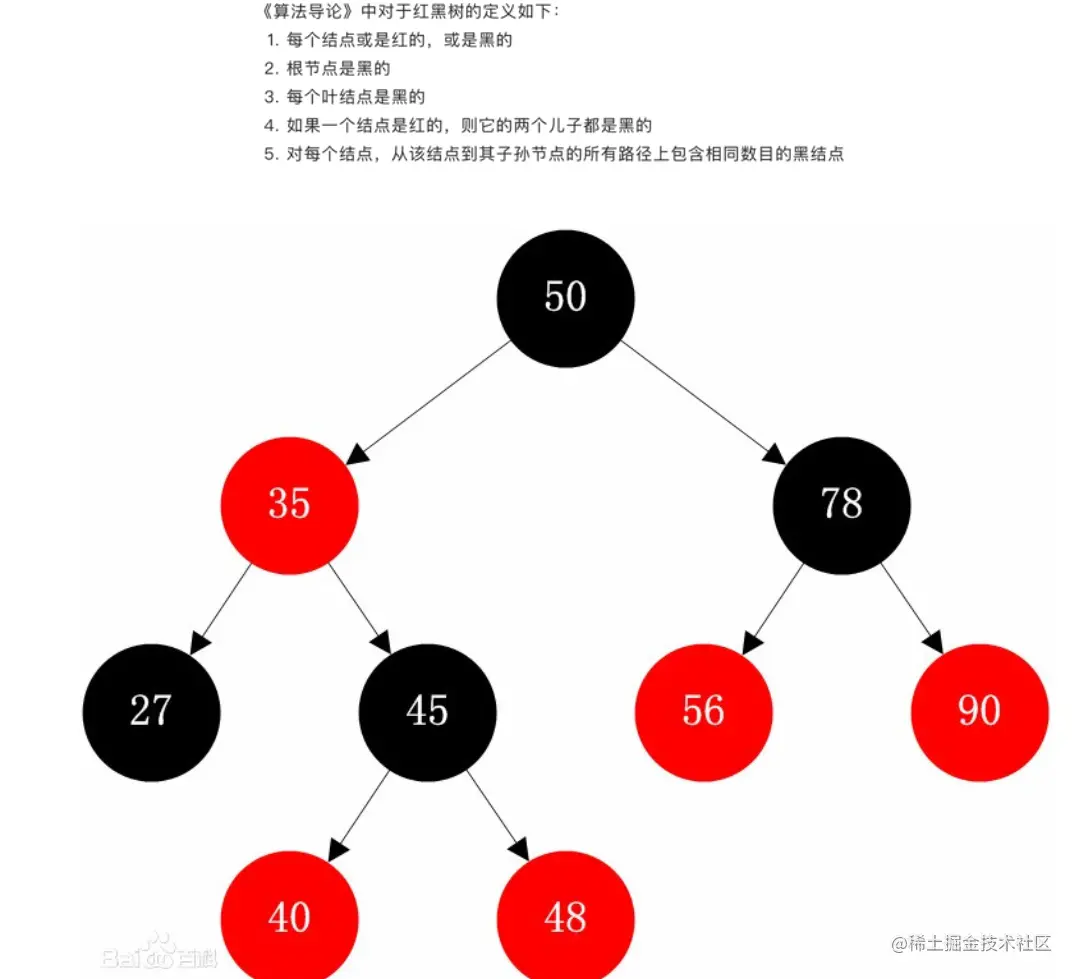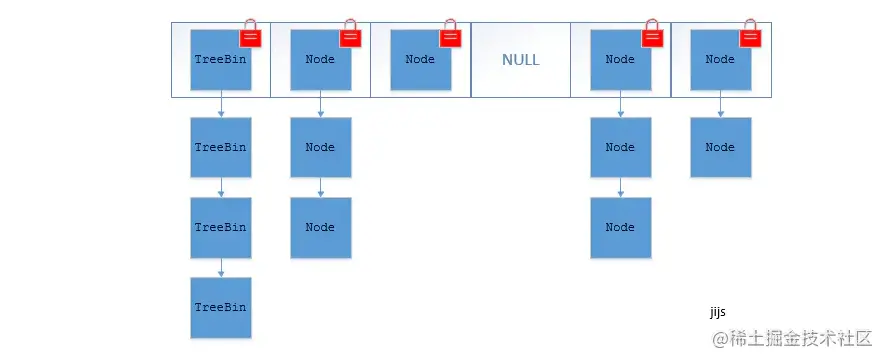# jdk7 HashMap
数组
数组存储区间是连续的,占用内存严重,故空间复杂的很大。但数组的二分查找时间复杂度小,为 O(1) ;
HashMap 里面实现一个静态内部类 Entry,Entry 包含四个属性: key,value,hash 值和用于单向链表的 next 。 Entry 就是 HashMap 键值对实现的一个基础 bean ,我们上面说到 HashMap 的基础就是一个线性数组,这个数组就是 Entry[],Map 里面的内容都保存在 Entry[] 里面
链表
链表存储区间离散,占用内存比较宽松,故空间复杂度很小,但时间复杂度很大,为 O(N) 。
1 2 3 static int indexFor (int h, int length) return h & (length-1 ); }
在 1.8 之前是这样的头插法:当 put 时要插入的元素的索引有重复时,会发生 hash 冲突碰撞,此时链表发挥作用:新插入的 Entry 的 next 指针指向旧的 Entry ,并通过修改当前索引位置的引用地址指向新的 Entry ,链表向下移动从而取代旧 Entry 的位置,放在数组相应索引位置,
哈希表 那么我们能不能综合两者的特性,做出一种寻址容易,插入删除也容易的数据结构?答案是肯定的,这就是我们要提起的哈希表。哈希表 ((Hash table) 既满足了数据的查找方便,同时不占用太多的内容空间,使用也十分方便。
每个数据对象的 hash 对应唯一一个值,但是一个 hash 值不一定对应唯一的数据对象。如果两个不同对象的 hash 哈希冲突。
哈希表是由数组 + 链表组成的,一个长度为 16 的数组中,每个数组中元素存储的是一个链表的头结点。
1 2 3 4 public HashMap () this (DEFAULT_INITIAL_CAPACITY, DEFAULT_LOAD_FACTOR); }
1 2 3 4 5 6 7 8 9 10 11 12 13 14 15 16 17 18 19 20 21 public HashMap (int initialCapacity, float loadFactor) if (initialCapacity < 0 ) throw new IllegalArgumentException("Illegal initial capacity: " + initialCapacity); if (initialCapacity > MAXIMUM_CAPACITY) initialCapacity = MAXIMUM_CAPACITY; if (loadFactor <= 0 || Float.isNaN(loadFactor)) throw new IllegalArgumentException("Illegal load factor: " + loadFactor); int capacity = 1 ; while (capacity < initialCapacity) capacity <<= 1 ; this .loadFactor = loadFactor; threshold = (int )Math.min(capacity * loadFactor, MAXIMUM_CAPACITY + 1 ); table = new Entry[capacity]; useAltHashing = sun.misc.VM.isBooted() && (capacity >= Holder.ALTERNATIVE_HASHING_THRESHOLD); init(); }
1 2 3 4 5 6 7 8 9 10 11 12 13 14 15 16 17 18 19 20 21 22 public V put (K key, V value) if (key == null ) return putForNullKey(value); int hash = hash(key); int i = indexFor(hash, table.length); for (Entry<K,V> e = table[i]; e != null ; e = e.next) { Object k; if (e.hash == hash && ((k = e.key) == key || key.equals(k))) { V oldValue = e.value; e.value = value; e.recordAccess(this ); return oldValue; } } modCount++; addEntry(hash, key, value, i); return null ; }
# put 头插法的问题数据插入使用头插法,会造成一个问题:resize 扩容时,里面有一个 resize 方法又调用了 transfer 方法,把里面一些 Entry 进行了 rehash ,在这个过程中可能造成一个链表的循环,可能导致在下一次 Get 时候出现要给死循环; 也有可能因为没有加锁,在多个线程并发情况下,不能保证数据安全,可能 put 一个值 get 出来还是那个值
数组 table 容量初始化( inflateTable )HashMap 的时候做一次数组的初始化,就是先确定初始的数组大小,并计算数组扩容的阈值。
1 2 3 4 5 6 7 8 9 10 private void inflateTable (int toSize) int capacity = roundUpToPowerOf2(toSize); threshold = (int ) Math.min(capacity * loadFactor, MAXIMUM_CAPACITY + 1 ); table = new Entry[capacity]; initHashSeedAsNeeded(capacity); }
# 计算具体数组位置( indexFor )取 hash 值的低 n 位。如在数组长度为 32 的时候,其实取的就是 key 的 hash 值的低 5 位,作为它在数组中的下标位置。
1 2 3 4 static int indexFor (int hash, int length) return hash & (length-1 ); }
# 添加节点到链表中( addEntry )
找到数组下标后,会先进行 key 判重,如果没有重复,就准备将新值放入到链表的表头。
主要逻辑就是先判断是否需要扩容,需要的话先扩容,然后再将这个新的数据插入到扩容后的数组的相应位置处的链表的表头。
1 2 3 4 5 6 7 8 9 10 11 12 13 14 15 16 17 18 19 void addEntry (int hash, K key, V value, int bucketIndex) if ((size >= threshold) && (null != table[bucketIndex])) { resize(2 * table.length); hash = (null != key) ? hash(key) : 0 ; bucketIndex = indexFor(hash, table.length); } createEntry(hash, key, value, bucketIndex); } void createEntry (int hash, K key, V value, int bucketIndex) Entry<K,V> e = table[bucketIndex]; table[bucketIndex] = new Entry<>(hash, key, value, e); size++; }
# 数组扩容( resize )
插入新值的时候,如果当前的 size 已经达到了阈值,并且要插入的数组位置上已经有元素,那么就会触发扩容,扩容后,数组大小为原来的 2 倍。
扩容就是用一个新的大数组替换原来的小数组,并将原来数组中的值迁移到新的数组中。
数组扩容是为了分散链表,让链表变短而使得 get 效率提高,加快查询效率
由于是双倍扩容,迁移过程中,会将原来 table[i] 中的链表的所有节点,分拆到新的数组的 newTable[i] 和 newTable[i + oldLength] 位置上。如原来数组长度是 16 ,那么扩容后,原来 table[0] 处的链表中的所有元素会被分配到新数组中 newTable[0] 和 newTable[16] 这两个位置。代码比较简单,这里就不展开了。
毛病:在多线程扩容时有可能会出现循环链表的情况,导致在 get 时会循环遍历。起因是扩容时使用头插法,导致 next 在结点 e 之前,使得数据顺序发生变化
解决方法:防止 hash 扩容,具体可以控制阈值 threshold 大于所需要的数组。还可以加锁、并发安全控制
1 2 3 4 5 6 7 8 9 void addEntry (int hash, K key, V value, int bucketIndex) if ((size >= threshold) && (null != table[bucketIndex])) { resize(2 * table.length); hash = (null != key) ? hash(key) : 0 ; bucketIndex = indexFor(hash, table.length); } createEntry(hash, key, value, bucketIndex); }
1 2 3 4 5 6 7 8 9 10 11 12 13 14 void resize (int newCapacity) Entry[] oldTable = table; int oldCapacity = oldTable.length; if (oldCapacity == MAXIMUM_CAPACITY) { threshold = Integer.MAX_VALUE; return ; } Entry[] newTable = new Entry[newCapacity]; transfer(newTable, initHashSeedAsNeeded(newCapacity)); table = newTable; threshold = (int )Math.min(newCapacity * loadFactor, MAXIMUM_CAPACITY + 1 ); }
# get 过程分析
根据 key 计算 hash 值。
找到相应的数组下标: hash & (length - 1) 。
遍历该数组位置处的链表,直到找到相等 (==或equals) 的 key 。
1 2 3 4 5 6 7 8 9 public V get (Object key) if (key == null ) return getForNullKey(); Entry<K,V> entry = getEntry(key); return null == entry ? null : entry.getValue(); }
1 2 3 4 5 6 7 8 9 10 11 12 13 14 15 16 17 final Entry<K,V> getEntry (Object key) if (size == 0 ) { return null ; } int hash = (key == null ) ? 0 : hash(key); for (Entry<K,V> e = table[indexFor(hash, table.length)]; e != null ; e = e.next) { Object k; if (e.hash == hash && ((k = e.key) == key || (key != null && key.equals(k)))) return e; } return null ; }
# remove 1 2 3 4 5 6 7 8 9 10 11 12 13 14 15 16 17 18 19 20 21 22 23 24 25 26 final Entry<K,V> removeEntryForKey (Object key) int hash = (key == null ) ? 0 : hash(key); int i = indexFor(hash, table.length); Entry<K,V> prev = table[i]; Entry<K,V> e = prev; while (e != null ) { Entry<K,V> next = e.next; Object k; if (e.hash == hash && ((k = e.key) == key || (key != null && key.equals(k)))) { modCount++; size--; if (prev == e) table[i] = next; else prev.next = next; e.recordRemoval(this ); return e; } prev = e; e = next; } return e; }
1.7 的插入存储底层实现:
数组 (默认长度为 16bit ,源码默认容量 = 1 << 4 , 最大容量限制: 1 << 30 ):
数组中还可以存放数组,每个数组中的一个存储单元存储的是 Entry (属性包括: key, value, hash,Node<K,V> next (数组 + 链表)) 结构的数据, Entry 的实现是一个链表 Node (属性和 Entry 相同)。其中元素在数组中的存储索引下标可以通过:( hash % arr.length-1 ) 得出
1 2 3 4 5 put(key, value){ int hashcode = key.hashcode(); int index = hashcode % table.legnth; table[index] = new Entry(key, value, table[index]); }
# jdk8 HashMap
1.7 之前 put 是头插法, 1.8 之后是尾插法,头插法会出现链表循环的问题,后者不会,但都不是线程安全
数组:一段连续的存储单元来存储结构,插入慢 O(n) 查找快 O(1) ; 链表 Node :一种物理存储单元上非连续、非顺序的存储结构,插入快 O(1) 查找慢 O(n)
HashMap 线程不安全,底层没有锁,线程安全的 HashMap:Collections.synchronizedMap()、new ConcurrentHashMap<>() ;
HashMap 底层是:数组 + Node 链表 + 的红黑树,每个数据单元都是一个 Node 结构。容量为 16 ,负载因子 0.75 (即装载的内存超过容量的 3/4 会自动扩容, HashMap 扩容为当前的 2 倍,即 2^(4+1) , ArrayList 扩容为原来的一半).
hashMap 的散列表,采用懒加载机制,只有第一次 put 时才会创建,而不是 new 就创建
Node 结构中包含 key、value、next、hash 字段,其中 next 字段是当发生 hash 冲突时,当前桶位中的 node 与冲突 node 连成一个链表要用的字段
hash 值是通过 key.hashCode() 二次加工得到的,加工原则是 key.hashCode() ^ (key.hashCode() >>> 16) , 即高 16 位和低 16 位的异或。这样做主要是为了加大散列程度的散列化,也是因为 hash 寻址算法的缘故:
HashMap 可以存放 key 为空的元素: map.put(null, "xxx") 当 key 为 null 时, JVM 会单独分配一片空间用来存放该值,再次 put 一个 key 为 null 的值时会覆盖之前的
capacity :当前数组容量,始终保持 2^n ,可以扩容,扩容后数组大小为当前的 2 倍。
loadFactor :负载因子,默认为 0.75 。
threshold :扩容的阈值,等于 capacity * loadFactor 。
1、扩容的数组的长度为什么保持 2^n?
其实这是为了保证通过 hash 方式获取下标的时候分布均匀。数组长度为 2 的 n 次幂的时候,不同的 key 算得的 index 相同的几率较小,那么数据在数组上分布就比较均匀,也就是说碰撞的几率小,相对的,查询的时候就不用遍历某个位置上的链表,这样查询效率也就较高了。
2、为什么负载因子的值默认为 0.75?
加载因子是表示 Hash 表中元素的填满的程度。
Java7 HashMap ,查找的时候,根据 hash 值我们能够快速定位到数组的具体下标,但是之后的话,需要顺着链表一个个比较下去才能找到我们需要的,时间复杂度取决于链表的长度,为 O(n) 。
为了降低这部分的开销,在 Java8 中,当链表中的元素达到了 8 个,且散列表数组长度已经达到 64 ,会将链表转换为红黑树,否则进行数组扩容,在这些位置进行查找的时候可以降低时间复杂度为 O(logN) 。
链表转化为红黑树有两个条件:
putVal 时进行判断,链表长度到达 8 调用 treeifyBin 转换红黑树的方法
1 2 if (binCount >= TREEIFY_THRESHOLD - 1 ) treeifyBin(tab, hash);
但在转换红黑树前还会进行判断:数组长度是否小于 64 ,小于则散列表 resize 扩容,大于等于 64 则链表转红黑树
1 2 3 4 5 6 7 8 9 10 11 12 13 14 15 16 17 18 19 20 21 22 final void treeifyBin (Node<K,V>[] tab, int hash) int n, index; Node<K,V> e; if (tab == null || (n = tab.length) < MIN_TREEIFY_CAPACITY) resize(); else if ((e = tab[index = (n - 1 ) & hash]) != null ) { TreeNode<K,V> hd = null , tl = null ; do { TreeNode<K,V> p = replacementTreeNode(e, null ); if (tl == null ) hd = p; else { p.prev = tl; tl.next = p; } tl = p; } while ((e = e.next) != null ); if ((tab[index] = hd) != null ) hd.treeify(tab); } }
当数组其中一个索引位置上的链表长度大于 8 时,调用转换红黑树方法 treeifyBin
当前散列表数组长度已经达到 64 ,两个指标都要达到,否则就算 slot 内部链表长度达到 8 也不会链转树,而是发生一次 resize 散列表扩容
# 红黑树 RB-Tree
二叉查找树是不平衡的,可能会变成链表,因此需要采用红黑树( RB-Tree ),插入和查询的 O(n) = logn
红黑树只需要保证黑色结点高度平衡,且满足以下 5 个条件
# 红黑树插入结点规律:根结点是黑色的,不用进行调整
叔叔的空的,旋转 + 变色 (祖父结点和父节点变色)
叔叔的红色,父节点 + 叔叔节点变黑色,祖父结点变红色
叔叔是黑色,旋转 + 变色
# 红黑树主要特性
每个节点要么是黑色,要么是红色。(节点非黑即红)
根节点是黑色。
每个叶子节点( NIL )是黑色。
如果一个节点是红色的,则它的子节点必须是黑色的。(也就是说父子节点不能同时为红色)
从一个节点到该节点的子孙节点的所有路径上包含相同数目的黑节点。(这一点是平衡的关键)
# 红黑树的插入1 2 3 4 5 6 7 8 9 10 11 12 13 14 15 16 17 18 19 20 21 22 23 24 25 26 27 28 29 30 31 32 33 34 35 36 37 38 39 40 41 42 43 44 45 46 47 48 49 50 51 52 53 54 static <K,V> TreeNode<K,V> balanceInsertion (TreeNode<K,V> root, TreeNode<K,V> x) x.red = true ; for (TreeNode<K,V> xp, xpp, xppl, xppr;;) { if ((xp = x.parent) == null ) { x.red = false ; return x; } else if (!xp.red || (xpp = xp.parent) == null ) return root; if (xp == (xppl = xpp.left)) { if ((xppr = xpp.right) != null && xppr.red) { xppr.red = false ; xp.red = false ; xpp.red = true ; x = xpp; } else { if (x == xp.right) { root = rotateLeft(root, x = xp); xpp = (xp = x.parent) == null ? null : xp.parent; } if (xp != null ) { xp.red = false ; if (xpp != null ) { xpp.red = true ; root = rotateRight(root, xpp); } } } } else { if (xppl != null && xppl.red) { xppl.red = false ; xp.red = false ; xpp.red = true ; x = xpp; } else { if (x == xp.left) { root = rotateRight(root, x = xp); xpp = (xp = x.parent) == null ? null : xp.parent; } if (xp != null ) { xp.red = false ; if (xpp != null ) { xpp.red = true ; root = rotateLeft(root, xpp); } } } } } }
Java7 中使用 Entry 来代表每个 HashMap 中的数据节点, Java8 中使用 Node ,基本没有区别,都是 key,value,hash 和 next 这四个属性,不过, Node 只能用于链表的情况,红黑树的情况需要使用 TreeNode。 Node 还是 TreeNode 来判断该位置下是链表还是红黑树的。
# Put 方法:和 Java7 稍微有点不一样的地方就是, Java7 是先扩容后插入新值的, Java8 先插值再扩容1 2 3 4 5 6 7 8 9 10 11 12 13 14 15 16 17 18 19 20 21 22 23 24 25 26 27 28 29 30 31 32 33 34 35 36 37 38 39 40 41 42 43 44 45 46 47 48 49 50 51 52 53 54 55 56 57 58 59 60 61 62 63 public V put (K key, V value) return putVal(hash(key), key, value, false , true ); } final V putVal (int hash, K key, V value, boolean onlyIfAbsent, boolean evict) Node<K,V>[] tab; Node<K,V> p; int n, i; if ((tab = table) == null || (n = tab.length) == 0 ) n = (tab = resize()).length; if ((p = tab[i = (n - 1 ) & hash]) == null ) tab[i] = newNode(hash, key, value, null ); else { Node<K,V> e; K k; if (p.hash == hash && ((k = p.key) == key || (key != null && key.equals(k)))) e = p; else if (p instanceof TreeNode) e = ((TreeNode<K,V>)p).putTreeVal(this , tab, hash, key, value); else { for (int binCount = 0 ; ; ++binCount) { if ((e = p.next) == null ) { p.next = newNode(hash, key, value, null ); if (binCount >= TREEIFY_THRESHOLD - 1 ) treeifyBin(tab, hash); break ; } if (e.hash == hash && ((k = e.key) == key || (key != null && key.equals(k)))) break ; p = e; } } if (e != null ) { V oldValue = e.value; if (!onlyIfAbsent || oldValue == null ) e.value = value; afterNodeAccess(e); return oldValue; } } ++modCount; if (++size > threshold) resize(); afterNodeInsertion(evict); return null ; }
1 2 3 4 5 6 7 8 9 10 11 12 13 14 15 16 17 18 19 20 21 22 23 24 25 26 27 28 29 30 31 32 33 34 35 36 37 38 39 40 41 42 43 44 45 final TreeNode<K,V> putTreeVal (HashMap<K,V> map, Node<K,V>[] tab, int h, K k, V v) Class<?> kc = null ; boolean searched = false ; TreeNode<K,V> root = (parent != null ) ? root() : this ; for (TreeNode<K,V> p = root;;) { int dir, ph; K pk; if ((ph = p.hash) > h) dir = -1 ; else if (ph < h) dir = 1 ; else if ((pk = p.key) == k || (k != null && k.equals(pk))) return p; else if ((kc == null && (kc = comparableClassFor(k)) == null ) || (dir = compareComparables(kc, k, pk)) == 0 ) { if (!searched) { TreeNode<K,V> q, ch; searched = true ; if (((ch = p.left) != null && (q = ch.find(h, k, kc)) != null ) || ((ch = p.right) != null && (q = ch.find(h, k, kc)) != null )) return q; } dir = tieBreakOrder(k, pk); } TreeNode<K,V> xp = p; if ((p = (dir <= 0 ) ? p.left : p.right) == null ) { Node<K,V> xpn = xp.next; TreeNode<K,V> x = map.newTreeNode(h, k, v, xpn); if (dir <= 0 ) xp.left = x; else xp.right = x; xp.next = x; x.parent = x.prev = xp; if (xpn != null ) ((TreeNode<K,V>)xpn).prev = x; moveRootToFront(tab, balanceInsertion(root, x)); return null ; } } }
# 数组扩容: resize() 方法用于初始化数组或数组扩容,每次扩容后,容量为原来的 2 倍,并进行数据迁移。1 2 3 4 5 6 7 8 9 10 11 12 13 14 15 16 17 18 19 20 21 22 23 24 25 26 27 28 29 30 31 32 33 34 35 36 37 38 39 40 41 42 43 44 45 46 47 48 49 50 51 52 53 54 55 56 57 58 59 60 61 62 63 64 65 66 67 68 69 70 71 72 73 74 75 76 77 78 79 80 81 82 83 84 85 86 final Node<K,V>[] resize() { Node<K,V>[] oldTab = table; int oldCap = (oldTab == null ) ? 0 : oldTab.length; int oldThr = threshold; int newCap, newThr = 0 ; if (oldCap > 0 ) { if (oldCap >= MAXIMUM_CAPACITY) { threshold = Integer.MAX_VALUE; return oldTab; } else if ((newCap = oldCap << 1 ) < MAXIMUM_CAPACITY && oldCap >= DEFAULT_INITIAL_CAPACITY) newThr = oldThr << 1 ; } else if (oldThr > 0 ) newCap = oldThr; else { newCap = DEFAULT_INITIAL_CAPACITY; newThr = (int )(DEFAULT_LOAD_FACTOR * DEFAULT_INITIAL_CAPACITY); } if (newThr == 0 ) { float ft = (float )newCap * loadFactor; newThr = (newCap < MAXIMUM_CAPACITY && ft < (float )MAXIMUM_CAPACITY ? (int )ft : Integer.MAX_VALUE); } threshold = newThr; Node<K,V>[] newTab = (Node<K,V>[])new Node[newCap]; table = newTab; if (oldTab != null ) { for (int j = 0 ; j < oldCap; ++j) { Node<K,V> e; if ((e = oldTab[j]) != null ) { oldTab[j] = null ; if (e.next == null ) newTab[e.hash & (newCap - 1 )] = e; else if (e instanceof TreeNode) ((TreeNode<K,V>)e).split(this , newTab, j, oldCap); else { Node<K,V> loHead = null , loTail = null ; Node<K,V> hiHead = null , hiTail = null ; Node<K,V> next; do { next = e.next; if ((e.hash & oldCap) == 0 ) { if (loTail == null ) loHead = e; else loTail.next = e; loTail = e; } else { if (hiTail == null ) hiHead = e; else hiTail.next = e; hiTail = e; } } while ((e = next) != null ); if (loTail != null ) { loTail.next = null ; newTab[j] = loHead; } if (hiTail != null ) { hiTail.next = null ; newTab[j + oldCap] = hiHead; } } } } } return newTab; }
# get 分析过程
计算 key 的 hash 值,根据 hash 值找到对应数组下标: hash & (length-1) .
判断数组该位置处的元素是否刚好就是我们要找的,如果不是,走第三步.
判断该元素类型是否是 TreeNode ,如果是,用红黑树的方法取数据,如果不是,走第四步.
遍历链表,直到找到相等 ( == 或 equals ) 的 key .
1 2 3 4 public V get (Object key) Node<K,V> e; return (e = getNode(hash(key), key)) == null ? null : e.value; }
1 2 3 4 5 6 7 8 9 10 11 12 13 14 15 16 17 18 19 20 21 22 23 final Node<K,V> getNode (int hash, Object key) Node<K,V>[] tab; Node<K,V> first, e; int n; K k; if ((tab = table) != null && (n = tab.length) > 0 && (first = tab[(n - 1 ) & hash]) != null ) { if (first.hash == hash && ((k = first.key) == key || (key != null && key.equals(k)))) return first; if ((e = first.next) != null ) { if (first instanceof TreeNode) return ((TreeNode<K,V>)first).getTreeNode(hash, key); do { if (e.hash == hash && ((k = e.key) == key || (key != null && key.equals(k)))) return e; } while ((e = e.next) != null ); } } return null ; }
# 红黑树退化为链表1 2 3 4 5 6 7 8 9 if (lc <= UNTREEIFY_THRESHOLD) tab[index] = loHead.untreeify(map); else { tab[index] = loHead; if (hiHead != null ) loHead.treeify(tab); }
这里才用到了 UNTREEIFY_THRESHOLD 的判断,当红黑树节点元素小于等于 6 时,才调用 untreeify 方法转换回链表
# jdk8 concurentHashMap ConcurrentHashMap 取消了 segment 分段锁,而采用 CAS+synchronized 来保证并发安全,整个看起来就像是优化过且线程安全的 HashMap 。数据结构跟 HashMap1.8 的结构一样, Node 数组 + 链表 + 红黑树。 synchronized 只锁定当前链表或红黑二叉树的首节点,这样只要 hash 不冲突,就不会产生并发,效率又提升 N 倍。桶中的结构可能是链表,也可能是红黑树,红黑树是为了提高查找效率。
容器里保存的所有 BeanFactory 创建的单例 bean 都放在一个 ConcurrentHashMap 中
TreeBin :红黑树节点 Node :链表节点
1 2 3 4 5 6 7 8 9 10 11 12 13 14 15 16 17 18 19 20 21 22 23 24 25 26 27 28 29 30 31 32 33 34 35 36 37 private static final int MAXIMUM_CAPACITY = 1 << 30 ; private static final int DEFAULT_CAPACITY = 16 ; static final int MAX_ARRAY_SIZE = Integer.MAX_VALUE - 8 ; private static final int DEFAULT_CONCURRENCY_LEVEL = 16 ; private static final float LOAD_FACTOR = 0 .75f ; static final int TREEIFY_THRESHOLD = 8 ; static final int UNTREEIFY_THRESHOLD = 6 ; static final int MIN_TREEIFY_CAPACITY = 64 ; private static final int MIN_TRANSFER_STRIDE = 16 ; private static int RESIZE_STAMP_BITS = 16 ; private static final int MAX_RESIZERS = ( 1 << ( 32 - RESIZE_STAMP_BITS)) - 1 ; private static final int RESIZE_STAMP_SHIFT = 32 - RESIZE_STAMP_BITS; static final int MOVED = - 1 ; static final int TREEBIN = - 2 ; static final int RESERVED = - 3 ; static final int NCPU = Runtime.getRuntime().availableProcessors(); transient volatile Node<K,V>[] table; private transient volatile int sizeCtl;
# HashMap 没有的属性1 2 3 4 5 6 7 8 9 10 11 12 13 14 15 16 17 18 19 20 21 22 23 24 private transient volatile int sizeCtl; private static int RESIZE_STAMP_BITS = 16 ; private static final int RESIZE_STAMP_SHIFT = 32 - RESIZE_STAMP_BITS; static final int MOVED = -1 ; static final int TREEBIN = -2 ;
Nod Node 是 ConcurrentHashMap 存储结构的基本单元,继承于 HashMap 中的 Entry ,用于存储数据。就是一个链表,但是只允许对数据进行查找,不允许进行修改TreeNode TreeNode 继承于 Node ,但是数据结构换成了二叉树结构,它是红黑树的数据的存储结构,用于红黑树中存储数据,当链表的节点数大于 8 时会转换成红黑树的结构,他就是通过 TreeNode 作为存储结构代替 Node 来转换成黑红树源代码如下TreeBin TreeBin 从字面含义中可以理解为存储树形结构的容器,而树形结构就是指 TreeNode ,所以 TreeBin 就是封装 TreeNode 的容器,它提供转换黑红树的一些条件和锁的控制,部分源码结构如下
# 利用 CAS 和 Synchronized 进行高效的同步更新数据。1 2 3 4 5 6 7 8 9 10 11 12 13 14 15 16 17 18 19 20 21 22 23 24 25 26 27 28 29 30 31 32 33 34 35 36 37 38 39 40 41 42 43 44 45 46 47 48 49 50 51 52 53 54 55 56 57 58 59 60 61 62 63 64 65 66 67 68 69 70 71 72 73 74 75 76 77 78 79 80 81 82 83 84 85 86 87 public V put (K key, V value) return putVal(key, value, false ); } final V putVal (K key, V value, boolean onlyIfAbsent) if (key == null || value == null ) throw new NullPointerException(); int hash = spread(key.hashCode()); int binCount = 0 ; for (Node<K,V>[] tab = table;;) { Node<K,V> f; int n, i, fh; if (tab == null || (n = tab.length) == 0 ) tab = initTable(); else if ((f = tabAt(tab, i = (n - 1 ) & hash)) == null ) { if (casTabAt(tab, i, null , new Node<K,V>(hash, key, value, null ))) break ; } else if ((fh = f.hash) == MOVED) tab = helpTransfer(tab, f); else { V oldVal = null ; synchronized (f) { if (tabAt(tab, i) == f) { if (fh >= 0 ) { binCount = 1 ; for (Node<K,V> e = f;; ++binCount) { K ek; if (e.hash == hash && ((ek = e.key) == key || (ek != null && key.equals(ek)))) { oldVal = e.val; if (!onlyIfAbsent) e.val = value; break ; } Node<K,V> pred = e; if ((e = e.next) == null ) { pred.next = new Node<K,V>(hash, key, value, null ); break ; } } } else if (f instanceof TreeBin) { Node<K,V> p; binCount = 2 ; if ((p = ((TreeBin<K,V>)f).putTreeVal(hash, key, value)) != null ) { oldVal = p.val; if (!onlyIfAbsent) p.val = value; } } } } if (binCount != 0 ) { if (binCount >= TREEIFY_THRESHOLD) treeifyBin(tab, i); if (oldVal != null ) return oldVal; break ; } } } addCount(1L , binCount); return null ; }
# 注意点
判断 Node[] 数组是否初始化,没有则进行初始化操作
通过 hash 定位 Node[] 数组的索引坐标,是否有 Node 节点,如果没有则使用 CAS 进行添加(链表的头结点),添加失败则进入下次循环。
检查到内部正在扩容,如果正在扩容,就帮助它一块扩容。
如果 f!=null ,则使用 synchronized 锁住 f 元素(链表 / 红黑二叉树的头元素)
如果是 Node (链表结构) 则执行链表的添加操作。
如果是 TreeNode (树型结果) 则执行树添加操作。
判断链表长度已经达到临界值 8 就需要把链表转换为树结构。
JDK8 中的 concurrentHashMap 实现是锁分离的思想,它把锁分的比 segment(JDK1.7) 更细一些,只要 hash 不冲突,就不会出现并发获得锁的情况。它首先使用无锁操作 CAS 插入头结点,如果插入失败,说明已经有别的线程插入头结点了,再次循环进行操作。如果头结点已经存在,则通过 synchronized 获得头结点锁,进行后续的操作。性能比 segment 分段锁又再次提升。
# Synchronized 在 1.6 之后锁升级的过程一个对象一开始是无锁的状态,或者说是可偏向状态,会先去判断下,再进行升级过程。锁是支持偏向锁的,当付钱获取到锁的这个线程,会优先让它再去获取到这个锁,如果没有获取到这个锁,就升级成一个轻量级的 CAS 锁,即乐观锁,乐观锁是比较有交 S 换的过程;如果 CAS 没有设置成功就会进行一个自旋,自旋到一定次数才会升级成一个 Synchronized 这个重量级锁,保证了性能问题
# 面试
为什么 HashMap 使用红黑树而不使用 AVL 树
CurrentHashMap 中加读写锁,实际上是读写锁,如果写冲突就会等待,如果插入时间过长必然等待时间更长,而红黑树相对 AVL 树他的插入更快!
插入和删除方面, AVL 树速度较慢:需要更高的旋转次数才能在修改时正确地重新平衡数据结构。
两个都给 O(log n) 查找,但平衡 AVL 树可能需要 O(log n) 旋转,而红黑树将需要最多两次旋转使其达到平衡
AVL 树的旋转比红黑树的旋转更加难以平衡和调试。



